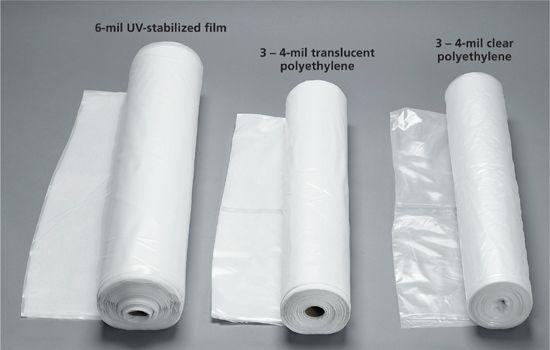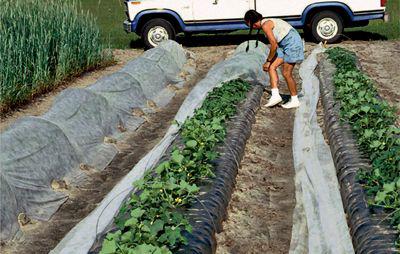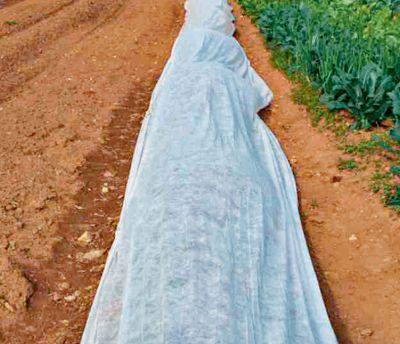Authors: Betsy Matheson
Tags: #Non-Fiction
DIY Projects for the Self-Sufficient Homeowner: 25 Ways to Build a Self-Reliant Lifestyle (18 page)

13 Attach the sheeting
to the outside edge of the base plate on one side. Roll sheeting over the roof and down the other side. Draw it taut and cut it slightly overlong with scissors. Attach retainer strips to the other base plate and then to the outside edges of the corner studs.
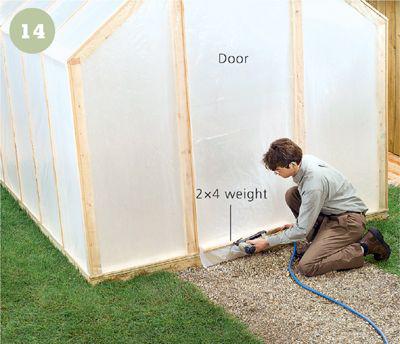
14 Make and hang
a door. We simply cut a piece of sheet plastic a little bigger than the opening (32") and hung it with retainer strips from the header. Attach a piece of 2 × 4 to the bottom of the door for weight.
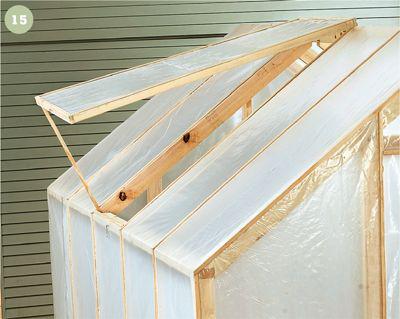
15
Option:
Make a vent
window. First, cut a hole in the roof in one rafter bay and tack the cut edges of the plastic to the faces (not the edges) of the rafters, ridge pole, and wall cap. Then build a frame from 1 × 2 stock that will span from the ridge to the top of the kneewall and extend a couple of inches past the rafters at the side of the opening. Clad the frame with plastic sheeting and attach it to the ridge pole with butt hinges. Install a screw-eye latch to secure it at the bottom. Make and attach props if you wish.

The hoophouse is a popular garden structure for two main
reasons: It is cheap to build and easy to build. In many agricultural areas you will see hoophouses snaking across vast fields of seedlings, protecting the delicate plants at their most vulnerable stages. Because they are portable and easy to disassemble, they can be removed when the plants are established and less vulnerable.
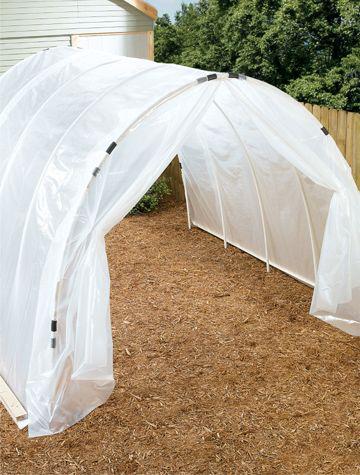
A hoophouse
is a temporary agricultural structure designed to be low-cost and portable. Also called Quonset houses and tunnel houses, hoophouses provide shelter and shade (depending on the film you use) and protection from wind and the elements. They will boost heat during the day, but are less efficient than paneled greenhouses for extending the growing season.
While hoophouses are not intended as inexpensive substitutes for real greenhouses, they do serve an important agricultural purpose. And building your own is a fun project that the whole family can enjoy.
The hoophouse shown here is essentially a Quonset-style frame of bent 3/4" PVC tubing draped with sheet plastic. Each semicircular frame is actually made from two 10-ft. lengths of tubing that fit into a plastic fitting at the apex of the curve. PVC tubes tend to stay together simply by friction-fitting into the fittings, so you don’t normally need to solvent glue the connections (this is important to the easy-to-disassemble and store feature). If you experience problems with the frame connections separating, try cutting 4" to 6"-long pieces of 1/2" (outside diameter) PVC tubing and inserting them into the tubes and fittings like splines. This will stiffen the connections.
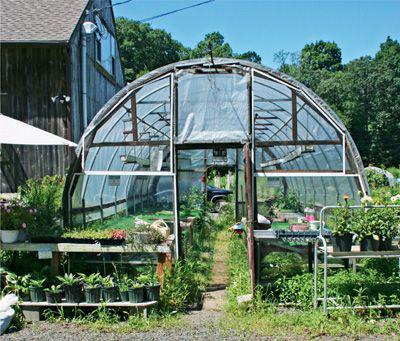
Hoophouse frames
can be made from wood instead of PVC plastic. Wood allows you to attach plastic sheeting with retainer strips and staples.
Building & Siting a Hoophouse
The fact that a hoophouse is a temporary structure doesn’t give you license to skimp on the construction. When you consider how light the parts are and how many properties sheet plastic shares with boat sails, the importance of securely anchoring your hoophouse becomes obvious. Use long stakes (at least 24") to anchor the tubular frames, and make sure you have plenty of excess sheeting at the sides of the hoophouse so the cover can be held down with ballast. Creating pockets at the ends of the sheeting and inserting scrap lumber is the ballasting technique shown here, but it is also common (especially when building in a field) to weigh down the sheeting by burying the ends in dirt. Only attach the sheeting at the ends of the tubular frame, and where possible, orient the structure so the prevailing winds won’t blow through the tunnel.
Building a Hoophouse
• Space frame hoops about 3 ft. apart.
• Leave ridge members a fraction of an inch (not more than 1/4") shorter than the span, which will cause the structure to be slightly shorter on top than at the base. This helps stabilize the structure.
• Orient the structure so the wall faces into the prevailing wind rather than the end openings.
• If you are using long-lasting greenhouse fabric for the cover, protect the investment by spray-painting the frame hoops with primer so there is no plastic-to-plastic contact.
• Because hoophouses are temporary structures that are designed to be disassembled or moved regularly, you do not need to include a base.
• The 3/4" PVC pipes used to make the hoop frames are sold in 10 ft. lengths. Two pipes fitted into a tee or cross fitting at the top will result in legs that are 10 ft. apart at the base and a ridge that is roughly 7 ft. tall.
• Clip the hoophouse covers to the end frames. Clips fastened at the intermediate hoops will either fly off or tear the plastic cover in windy conditions.
Row tunnels are
often used in vegetable gardens to protect sensitive plants in the spring and fall. Plastic or fabric sheeting is draped over a short wire or plastic framework to protect plants at night. During the heat of the day, the sheeting can be drawn back to allow plants direct sunlight.
